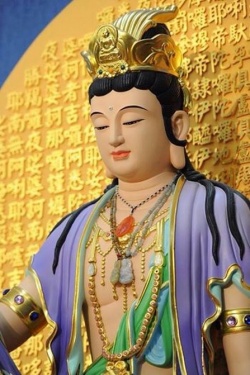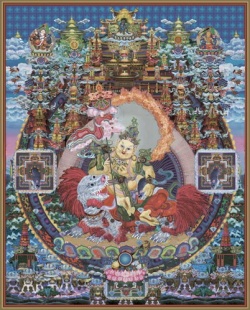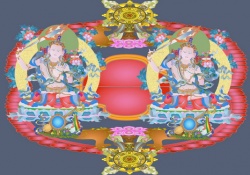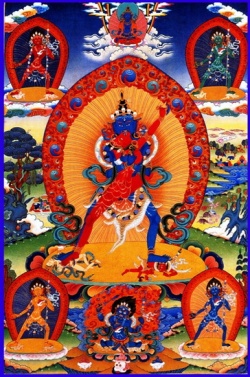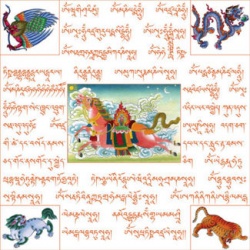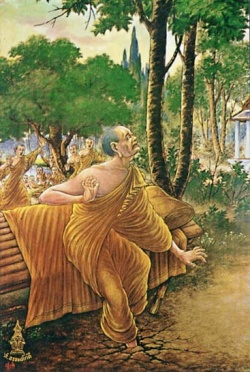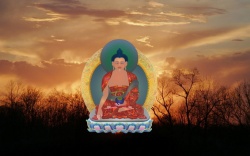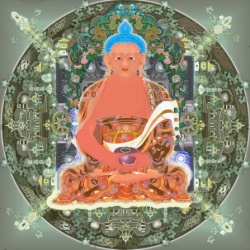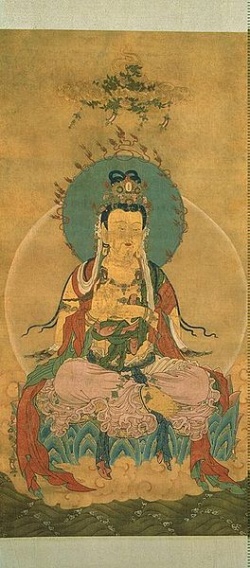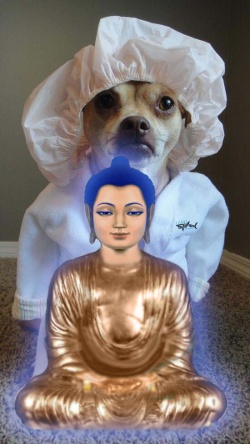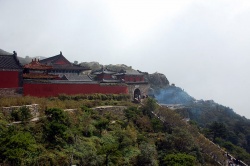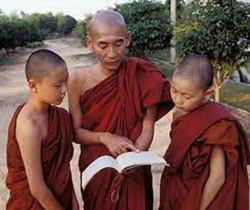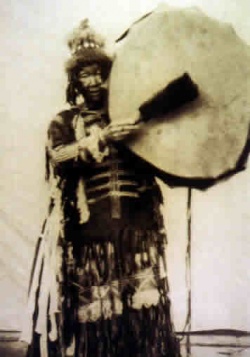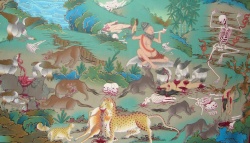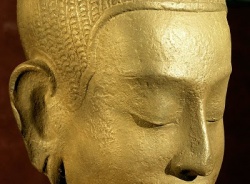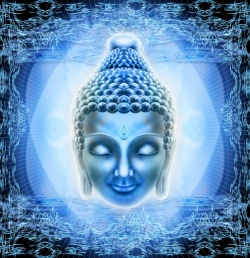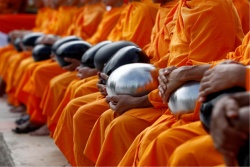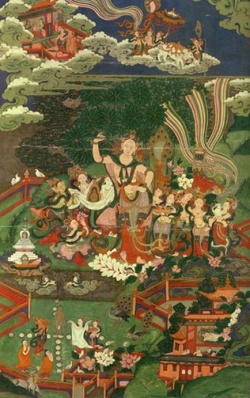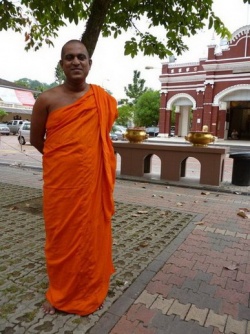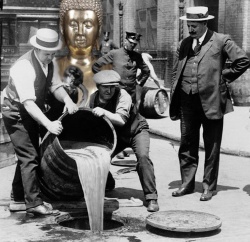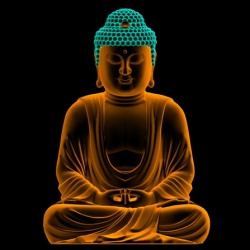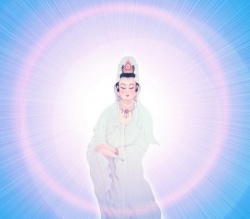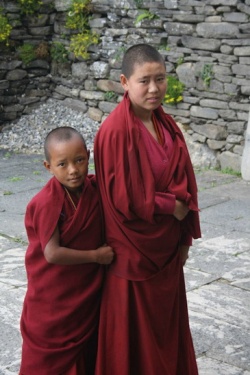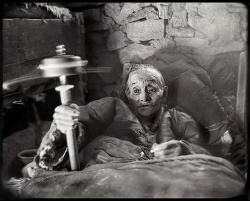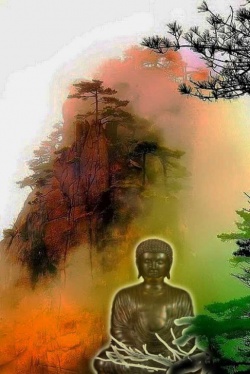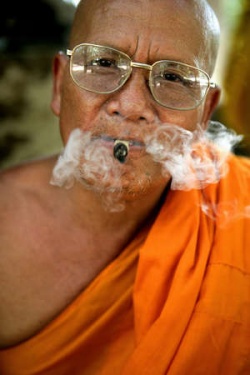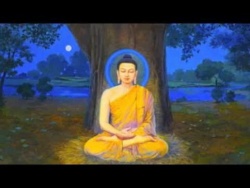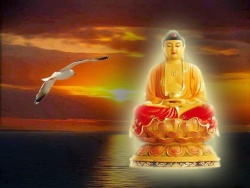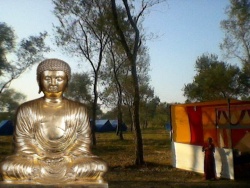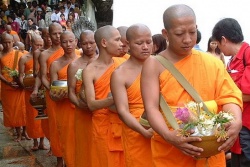The debate at bsam yas: religious contrast and correspondence
By Roccasalvo, Joseph F. Philosphy East and West 30:4(October,1980) P.505-520 (C) by The University of Press of Hawaii
HISTORICAL INTRODUCTION
In the book, Kumbum Dschamba Ling, a volume of Tibetan art dedicated to "the cloister of one hundred thousand pictures of Maitreya," Wilhelm Filchner describes the expulsion of the Chinese Buddhists from Tibet, as it remains a living tradition in the memory of the people in mythological form.
This event is enacted in the Tscham mystery-dances, which are performed yearly in the village monasteries, especially at Kumbum. He writes:
The theatrical element in the Tscham dances, which are brought to production in Kumbum, is presented and portrayed through Hwaschang and the four Atsaras.
Hwaschang is surrounded... by a group of similarly clothed children in similar masks. They portray his students, or, according to the other version, his children also, or indeed, boys who make fun of the odd old man.(1)
In his study of Buddhist mythology in Tibet and Mongolia, Albert Grunwedel further adds that the figure of Hva 'sa^n appears in an exaggerated and grotesque form as the representative of the ousted ston min pa, or, party of the sudden path.
He is held up to ridicule by the children of the village and is known among them as the monk with the oversized stomach.
In colloquial English we might say that Hva 'sa^n is scornfully called "the pot-bellied Buddha" (der Dickbauch-Buddha).(2)
The expulsion of the Chinese Buddhists, symbolically represented by the Tscham dances, determined that Tibet should not adopt the Ch'an version of Buddhism but Indian Mahaayaana.
This event has received conspicuously little attention in the text-books, and when it has, it is usually to the detriment of the Chinese contingent, whose doctrine of subitism has been grossly misunderstood to this day.
One striking example of such misunderstanding in past history was the debate held at bSam yas under the rule of K'ri sro^n lde btsan--the so-called Council of Lhasa.(3)
There in the late eighth century (792-794), the Chinese Mahaayaana Hva sa^n, a follower of the Dhyaana school, was sternly opposed by a group of Indian Mahaayaana Buddhists under the leadership of Kamala'siila.
According to the various Tibetan sources, especially Bu-ston's History of Buddhism (Chos-.hbyung), the Indian hostility is presented as a reaction against the growing influence of the Chinese masters who had won the majority of Tibetan Buddhists to their cause:
"The number of pupils of the Chinese Hva-sa^n Mahaayaana increased, "(4) Bu-ston tells us; he then proceeds to discuss the consequences of the effectively propagated teachings of the Chinese in whom "the Tibetans, for the greater part, found pleasure" (192).
Giuseppe Tucci remarks in this regard that "we do not know if the Indian party really lost a great number of its adherents; the sources agree in
telling us that they were the minority and that only some of the leading monks remained faithful to the teaching of the Bodhisattva Saantirak.sita.(5)
In any event, it is clear that the preaching of Hva 'sa^n Mahaayaana had steadily gained ground to such an extent that the king was compelled to intervene by staging a debate between the conflicting parties.
Paul Demieville, in his book Le Concile de Lhasa, which Tucci rightly calls "one of the most learned contributions to the history of cultural relations between China and Tibet as yet undertaken,"
(6) has suggested in his "Historical Commentary" that more than theological doctrines were at play in the Indian-Chinese debate at bSam yas. He writes:
That a sinophobic party had existed at the court of Tibet, and that it had backed the Buddhists of India, less suspicious of political compromises, nothing [is] more likely, especially since the rapport between China and Tibet was particularly strained at the end of the eighth century.
Across all her history, since her origins up to our present day, Tibet has been tossed between China and India; its politics have always tended to safeguard national independence by playing these powers, one against the other ... and in favoring that which the circumstances of the moment made appear the less dangerous.(7)
And "the circumstances of the moment" pointed to the fact that the Dhyaana school headed by Hva 'sa^n had gained enthusiastic acceptance among the Tibetan population, thereby threatening to assume proportions which were able to stir up latently hostile attitudes toward China. In whatever way we understand the political sentiments involved, the debate at bSam yas must be regarded as a historical event of the greatest importance, what Paul Demieville has aptly called "a major turn in the religious history of Tibet" (183).
Fortunately, (thanks
(1) to the Chinese dossier of Hva 'sa^n Mahaayaana which was recovered in the grotto of Tuen-huang,
(2) the Sanskrit text of the third Bhaavanaakrama,
(3) the longer Tibetan version of the latter, and
(4) Bu-ston's History of Buddhism, Part II), we are in a position today to make some judgments regarding what occurred during this disputation.
But regarding who actually won the debate there is no complete agreement between the Chinese records and the Tibetan tradition. According to the Chinese dossier translated by Demieville, the Tibetan king decided in favor of Hva sa^n by passing an edict in 794 confirming the doctrine of dhyaana as taught by the Chinese party (42).
The Tibetan sources, however, speak of the firm support given by K'ri sro^n Ide btsan to Kamala'siila and his point of view. Bu-ston writes in his History:
Thereafter the king gave the following order: --Henceforth, as concerns the theory, one must adopt the system of Naagaarjuna.
With regards to the practice--one must become trained in the 10 kinds of virtuous conduct and in the 10 Transcendental Virtues.
As to the Ton-mun views, the propagation of these is not to be permitted! -Accordingly the Hva-ca^n was sent back to China, and his books were collected and kept concealed in a storehouse. (195-196)
Tucci rightly points out in Minor Buddhist Texts that, in an edict intended for laymen, it is rather odd that Naagaarjuna is mentioned, for his name signified little to the Tibetan people at large.
He concludes that it is most probable
The king did not at all intervene in an energetic way in the debate: he attended it, followed the course of the discussion but did not evidently have the doctrinal preparation to be judge:
most probably he established at the conclusion of the debate that the doctrine to be followed was the Maadhyamika....
And this did not say very much, because neither sholar could deny resting on that system for a starting-point.(8)
No less a Tibetan scholar than David Snellgrove affirms the generally held opinion that Kamala'siila "came out the winner from the confrontation"
(9) and later composed three works(the Bhaavanaakrama) which expound the gradualist point of view which he had defended at the council.
Even if we suppose that Kamala'siila was proclaimed the victor, this does not imply that there occurred an immediate persecution of the Ch'an party.
The court and the ministers might have counselled that the doctrines of the Indian Mahaayaana be followed, but we have no reason to believe that steps were taken to impose the Indian theory on the people by force of edict.
As Tucci further suggests,
The impression which one gathers is that after the death of K'ri sro^n lde btsan there was a strong revival of Indian- Buddhism, caused not only by the direct instigation of the court, anxious to prevent any further Chinese influence, but also by the growing prestige of the Indians and the coming of Indian aacaaryas in greater numbers than before.(10)
Despite the ambiguity of the debate's outcome, it is historically indisputable that Tibetan Buddhism sat at the feet of Indian Mahaayaana for its religious tutelage.
While one cannot help but be fascinated by a religious debate which seems to have turned into a melodrama--with members of the two opposite parties having recourse to violence, suicide, and murder--the doctrinal issues,
themselves raised at the "council" are more than sufficient to focus the attention of the student of both Buddhism and comparative religion.
The question of sudden and gradual enlightenment, the value and disvalue of moral selfcultivation at certain stages, and the problem of language being employed from two distinct standpoints, all are issues structurally analogous to certain historical thought-trends within the Christian context of mysticism and doctrinal orthodoxy, faith, and works, as well as theological precision and religious hyperbole.
Within the Tibetan context, however, such difficulties become compounded to an even greater degree because of the linguistic disparity between the opposing parties, as Demieville points out in his "Introduction":
They [the Chinese party certainly did not know Sanskrit, any more than their Indian adversaries were familar with Chinese. The controversy must have developed around written fragments in Sanskrit and Chinese, with Tibetan
serving as common language for the two groups in the oral debate whatever language had been used, some thought in Sanskrit, others in Chinese (20-21).
Given such wide linguistic requirements together with nationalistic prejudices, it is not difficult to see how each side failed to comprehend fully its opponent's point of view.
In this brief study, my interest will not focus on the historical details of the controversy. These have been exhaustively examined by the two great Buddhologists,
Paul Demieville and Giuseppe Tucci, whose respective studies are models of clarity and erudition.
Rather, I should like to confine my attention to the two standpoints represented by Kamala'siila and Hva 'sa^n, especially since they have been made available to us in various edited and translated documents.
Such interest in the debate at bSam yas poses a number of striking questions for the comparative religionist who is concerned about the encounter of differing religious or philosophical perspectives.
The further importance of this inquiry also becomes apparent when we examine the writings of historians of this period.
In his book, The Religions of Tibet, Helmut Hoffmann characterizes the standpoints of our two religious protagonists in the following way:
The most important matters of doctrine in which Hva-shang differed from his Indian rival were
(1) the attainment of Buddhaship does not take place slowly as the result of a protracted and onerous moral struggle for understanding, but suddenly and intuitively--an idea which is characteristic of the Chinese Ch'an and of the Japanese Zen sect which derives from it;
(2) meritorious actions whether of word or deed, and, indeed, any spiritual striving, is evil; on the contrary one must relieve one's mind of all deliberate thought and abandon oneself to complete inactivity.(11)
Judging from Hoffmann's unnuanced characterization of Hva 'sa^n's position vis a vis Kamala'siila, one has further evidence of the kind of misunderstanding this debate may generate, even in the mind of a modern scholar.
In this article I will restrict myself, first, to an examination of the third Bhaavanaakvama as given in the French translation by Etienne Lamotte of the later Tibetan version, with an occasional reference to the recent Italian translation by Corrado Pensa (of the original Sanskrit version edited by Tucci).
Bu-ston's History of Buddhism will act as an important apologetic commentary on the Indian source-material. I will then turn my attention to the Chinese dossier of Hva 'sa^n as given in translation by Demieville.
The overall effort will be to ascertain the religious contrasts and correspondences between our two interlocutors, Kamala'siila and Hva 'sa^n Mahaayaana, concerning their views of gradual and sudden enlightenment. Of no less significance will be the endeavor of discovering how much mutual understanding and misunderstanding took place, and whether there is any suggestion that they embraced (however haltingly!) each other's frame of reference.
THE THIRD BHAAVANAAKRAMA OF KAMALASIILA
Several months before his death in 1935, the Russian scholar E. Obermiller pointed out a new document concerning the Sino-Tibetan controversy at bSam yas.
He had found a Sanskrit manuscript whose text was printed on Tibetan paper at the library of the Asiatic Museum in Leningrad.
It had been brought into Russia by the celebrated Siberian lama, Dorjeev, leader of the Russian Buddhists at that time.
The text is attributed to Kamala'siila and represents his side of the debate at bSam yas. As an appendix to the book by Paul Demieville, Etienne Lamotte translated this important treatise from its Tibetan version (336-353), with the crucial Sanskrit passages underlined. On the basis of the photographic copy which Giuseppe Tucci obtained from Leningrad and his own manuscript text, the Sanskrit version has recently been produced,(12) and it has been translated into Italian by Corrado Pensa.(13)
Both the Sanskrit and the Tibetan versions of the third Bhaavanaakrama are organized into three sections:
first, there is the careful exposition of the nature of 'samatha and vipa'syanaa with a discussion of the objects of these two mental operations prescribed for the yogi aspirant; second, there is a detailed presentation of "spiritual exercises" to be practiced by the yogin in conjunction with 'samatha and vipa'syanaa;
and third, the controversy with Ho-chang (Hva 'sa^n) is mentioned with a refutation of his quietism by establishing that it is contrary to the Great Vehicle, that it neglects essential means for attaining enlightenment, and that it is incapable of grasping 'suunyataa.
In the opening section Kamala'siila follows the Indian tradition by stressing the dual mental operations of 'samatha (stillness of mind) and vipa'syanaa (intensive meditation with a view to correct analysis).
These two activities of the mind are important, he tells us,because they unite all the forms of concentration which, when practiced assiduously, free one from bondage by destroying the obstacles (336-1337). Edward Conze describes the function of 'samatha in the context of yogic meditation in the following way:
...after some degree of contentment with the conditions of a solitary, beggarly, and homeless life has been achieved, the mind is at last capable of doing its proper yogic work.
This consists in systematically withdrawing attention from the objects of the senses..
And what could be the aim and outcome of this act of sustained introversion....
All the adepts of Yoga, whatever their theological or philosophical differences, agree that these practices result in a state of inward tranquility ('samatha).(14)
Hence, the point of 'samatha or mental stillness is to set the stage for the next operation, vipa'syanaa; wherein the object of meditation is focused efficaciously. Etienne Lamotte describes this level of concentration as a piercing view of insight,
(15) which has as its effect a profound penetration into 'things'. In other words, vipa'syannaa is that mental operation within which praj~naa occurs, resulting in an act of insight that sees dhnrmas as they are in themselves, that is, as
transitory and deprived of substantial reality.(16) Kamala'siila depends on imagery to describe this level of mental achievement.
By the force of 'samatha, thought (citta), like a lamp placed in shelter from the wind, does not swerve from its object (aalambanaan na vicalati);
by vipa'syanaa, the brilliance of true wisdom (bhuutapraj~naaloka) is born after the manner of a sunrise (suuryodaya) , by virtue of reflective examination conforming to the reality of things(yathaadharmattvam), and all the obstacles (aavara.na) are destroyed" (337).(17)
What Kamala'siila seems to be saying is that such intensively analytical meditation involved in the operation of vipa'syanaa leads to a judgmental act of extraordinary lucidity (praj~naa) wherein one sees the dharmas as they truly are, desires are eliminated ipso facto, attachments to the obstacles (sensuality, rebirth, vain speculation, and ignorance) are neutralized, and one is freed for the state of enlightenment.
In the second part of the first section, Kamala'siila proceeds to a discussion of the four levels of attainment in 'samatha and vipa'syanaa:
(1) reflections free of concepts;
(2) reflections accompanied by conceptual thought;
(3) knowledge of the proper nature of realities in which "the Yogin attains (upagacchati) all the dharmas according to their nature (yathaabhaavam)" (337), and
(4) the final transformation of the Yogi who "by means of the way of meditation (bhaavanaamaarga) revolutionizes his personality gradually (krame.naasraya^m paraavartayati) by the production of successive moments of purification (supravi'suddhik.sa.notpaadaat (338) .
Kamala'siilla's terse conclusion to this portion of his treatise is as follows:
"Consequently, he who desires to obtain the state of Buddha must practice 'samatha and vipa'syanaa; those who do not practice them do not grasp the final goal and do not succeed in the undertaking" (338).
It is important to note here how, from the outset, Kamala'siila insists in true Indian fashion on discovering the way in which the mind is structured to ascend in stages to the ultimate level, and to recognize how this goal is gradually appropriated by means of a process.
Our Indian protagonist emphasizes a step-by-step effort to enlightenment and thereby stresses the importance of concomitant psychic development through meditational practices.
In this way, the outflow of mental defilements is gradually purified and 'the final goal' is achieved.
Kamala'siila exhibits what might be called a picture-preference for viewing enlightenment from the standpoint of process rather than from the standpoint of the goal.
In the second part of the dossier Kamala'siila provides a practical guide for the yogin by detailing the order of spiritual exercises to be followed for the attainment of 'samatha and vipa'syanaa.
He suggests that the aspirant fix his thought on the various corporeal forms of the Tathaagata, and then, by examining their coming and going, realize that "they are empty of own-being (svabhaava-;suunya) and deprived of Me and Mine (aatmaatmiiyarahita)" (339).
It is vipa'syanaa which achieves this correct analysis by recognizing that phenomena ===== P.511
which succeed one another serially last but a moment and are bound to disappear, because as such they are deprived of all autonomy, neither constituting an Ego nor depending on one.
It is also vipa`syanaa which dispells the error due to ignorance which considers realities as 'Me' or 'Mine', thus detaching us from these fugitive entities.
Kasmala`siila's description of practices is exhaustively detailed, including a section on distraction and agitation during meditation with corresponding mental forms of recreation to refresh the yogin.
One is reminded here of the Roman Catholic Doctor Mysticus, John of the Cross whose analysis of the various stages of prayer and spiritual purification in The Ascent of Mount Carmel are as subtle as Kamala`siila's and, not infrequently, as laborious.
The third and last section of the Indian dossier deals with controversy with Ho-chan (Hva sa^n);as Demieville points out, "the Bhaavanaakrama, in Indian fashion,,does not make any mention either of China or of historically determine adversaries"(18).Kamla'siila gives a resume of the false, quietistic dectrine of "certain teachers":
By the force of good and bad acts coming from mental concepts (citta-vikalpa.samutthaapita-`subhaa`subha- krama-va'sena), beings wander in transmigration, enjoying heaven (svarga), etc., as the fruit of their acts; but those who do not think of anything and who do nothing are freed from transmigration (sa^msaaraat parimucyante).
Consequently (to attain Nirvaa.na) it is not necessary to think about anything, there is no further necessity to engage in good practices (ku`sala-caryaa), as giving (daana), etc.; the practice of giving, etc., has been prescribed solely through involvement with stupid people (kevala^m muurkhajanam adhik.rtya daanaadi-ku`sala-caryaa nirdi.s.taa)(348).
He then proceeds to refute Hva `sa^n's alleged position by showing that it is contrary to the spirit of the Great Vehicle of Mahaayaana.
First he tells us that "to say that (to attain Nirvaa.na) it is not necessary to think of anything, is to reject wisdom which has as its hallmark correct analysis" (348) .
Kamala`siila's continued insistence that correct analysis (which he has earlier equated with vipa`syanaa [340]) is the root of supramundane wisdom (praj~naa) is a valid recapitulation of the Indian tradition of meditation;
but such an assertion is true from the standpoint of one who stresses the step-by-step process to enlightenment, and this is not Hva `sa^n's position at all.
Kamala`siila's debating tactics are clear: he sets up what he claims to be Hva `sa^n's denial of a constant in the Indian meditational tradition, and then proceeds to deny that denial by a clever marshalling of texts by way of refutation.
His conclusion, then, is that one "who rejects correct analysis (bhuutapratyavek.saa) also rejeckts the principal instrument of illumination which is called the discernment of the dharmas (dharmapravicayaakhyaa^m.pradhaanam eva bodhya^ngam)" (349).
The second part of his refutation has to do with Hva `sa^n's supposed rejection of pious practices within the context of the bodhisattva ideal. He tells us that "to say as follows that it is not necessary to practice goodness, giving, etc., that is also to destroy the Mahaayaana by casting off giving, etc., which are
salvific means (upaaya). It is said in the AArya Gayaa'siir.sa: 'In summary, the way of the Bodhisattva involves two things... salvific means and wisdom' " (349) .
Once again, Kamala'siila attempts to refute Hva 'sa^n's so-called libertine view of the Indian tradition with regard to works by denying Hva 'sa^n's denial of a constant in the Great Vehicle; once again, one must remark (by anticipation) that such a gross oversimplification does not truly represent Hva 'sa^n's position at all.
In fact, as a careful examination of the Chinese dossier will show, our Chinese protagonist explicitly recognizes the importance of good works as well as the need for mind-cultivation, even in a gradualist's sense, but all from the standpoint of the process, not from that of the absolute goal.
Such misunderstanding of Hva 'sa^n continues in Bu-ston's History of Buddhism in an even more exaggerated fashion.
We are told that the followers of Hva 'sa^n "favored nihilistic views and did not exert themselves in the practice of virtue, saying:--By acting according to the Doctrine, by virtuous acts of body and speech, one cannot become a buddha.
One attains the state of the latter by abiding in perfect inactivity" (192).
According to Bu-ston, Hva 'sa^n makes a vain effort to marshall evidence for his unorthodox views by turning to the 'Satasaahasrikaa and other suutras to demonstrate that "action according to the Doctrine was unnecessary, and that it was sufficient to abide in a state of deep sleep" (192).
However, when he sees that the Sa^mdhinirmocana Suutra contradicts his conduct and views, we are told by Bu-ston that Hva 'sa^n "cast it away with a kick" (192).
The overall impression that the Tibetan commentator wishes to leave his reader is patently clear: Hva 'sa^n is not only the purveyor of false doctrine, he is also malicious.
This becomes clearer in Bu-ston's account of how the Chinese representatives reacted after the king gave the order that the Indian school of Buddhism was to be followed: "(the Chinese party) were enraged, armed themselves with sharp knives and threatened to kill all the Tsen-min-pa (the adherents of the Bodhisattva)" (192).
As the final proof of Hva 'sa^n's viciousness, and with details that appear to come straight from the Tibetan tabloids of the day, Bu-ston tells us that "four Chinese butchers, sent by Hva-Ca^n, killed the teacher Kamalaciila by squeezing his kydneys" (196).
According to A. K. Warder in his book, Indian Buddhism, Kamala'siila "was murdered, apparently, by followers of the ancient Tibetan religion."(18)
Whatever may be the historical truth, it is clear that by the time Bu-ston writes his History of Buddhism, Hva 'sa^n's antinomian character has become proverbial.
This supposed extra legem attitude of Hva 'sa^n is demonstrated in the only speech which Bu-ston permits him in the account of the debate at bSam yas:
If one commits virtuous or sinful deeds, one comes to blissful or to evil births (respectively). In such a way the deliverance from Sa^msaara is impossible, and there will always be impediments to the attainment of Buddhahood.
(The virtuous and the sinful deeds) are just like white and black clouds which alike
obscure the sky. But he who has no thoughts and inclinations at all, can be fully delivered from Phenomenal Life.
The absence of any thought, search, or investigation brings about the non-perception of the reality of separate entities.
In such a manner one can obtain (Buddhahood) at once, like (a Bodhisattva) who has attained the 10th Stage (193).
Bu-ston's presentation of Hva 'sa^n's alleged position regarding works is surprisingly close to Helmut Hoffmann's evaluation which has been previously cited, though the Tibetan commentator's prejudice leads him to caricature rather than oversimplification.
Yet through the caricatured position one can gain some insight into why such misunderstanding occurs. Bu-ston, like most commentators who are unsympathetic to Ch'an Buddhism, fails to understand the experiential direction of Ch'an language.
In their efforts to calm the mind so that the reality of the Buddha-nature can be apprehended, the Ch'an masters insist that intellectual analysis can only scratch the surface but cannot get at this most fundamental reality.
Furthermore, in any conscious thought or deed there is the ego at work, making for the distinction between subject and object.
Such conscious polarities beget karman, which ties one down to the recurrent cycle of birth and death, while deeds breed attachment to external goals including enlightenment.
Hence, when Hva 'sa^n speaks disparagingly of "virtuous and sinful deeds" and urges that one have "no thoughts and inclinations at all," he is exhorting such practices from the point of view of the goal, which sees Ultimate Reality as inconceivable in thought and inexpressible in word and deed.
According to Bu-ston's account, Kamala'siila argues that Hva 'sa^n's literal renunciation of all spiritual activity is precisely calculated to render impossible the attainment of praj~naa:
Thou sayest thus that one ought not to think about anything whatever.
But this means the negation (or rejection) of the Highest Analytic Wisdom [[[vipa'syanaa]]) likewise.
Now as the latter represents the foundation of the Divine Wisdom [[[praj~naa]]) of a Saint, the rejection of it necessarily leads to the negation of this sublime Transcendental Wisdom (193).
Kamala'siila has argued incisively and within the Indian meditational school of step-by-step process toward the goal, but he has missed the point Hva 'sa^n has been trying to make.
Kamala'siila's disciple, J~naanendra, is no less obtuse to the Chinese party's point of view. He goes still further in misunderstanding and suggests that Hva 'sa^n's approach is tantamount to the passivity of slumber:
"If we admit your point of view, it follows that... mental training is not required, and the knowledge of the worldly matters is unnecessary.
But, in such a case, how can the knowledge of everything cognizable be attained?
If you do nothing and only sleep, you will not even take food and thus die of hunger!" (195).
According to Bu-ston, the Chinese party (Ton-mun-pa) were unable to answer and declared themselves the losers by presenting the wreath
of flowers to Kamala'siila; the king then ordered that henceforth no one should regard the teachings of Hva 'sa^n Mahaayaana, and the writings of the vanquished party were collected and put under lock and key.
Despite Bu-ston's rather biased and exaggerated presentation of what went on at the debate at bSam yas, is there any indication from the third Bhaavanaakrma that Kamala'siila might have grasped, however briefly, Hva 'sa^n's point of view? There are certain remarks he makes at the end of the Sanskrit dossier which would suggest an affirmative answer.
After addressing himself to the question, how it would be possible to know the absence of the own-nature of dharmas as well as the memory of one's former existences, he answers that "without correct analysis (bhuutapratyavek.saa) , to practice the absence of memory and the absence of reflection (asm.rty-amanasikaara-bhaavanaa) , is to practice foolishness" (351) .
Though Kamala'siila has maintained this critique from the point of view of the process, for a moment he qualifies his accustomed position by admitting that "from the absolute point of view (paramaarthata.h), one may speak of the absence of memory (asm.rti) and the absence of reflection (amanasikaara) " [[[Wikipedia:emphasis|emphasis]] mine] (352).
But he continues to maintain that this necessarily must be preceded by correct analysis.
Actually, this latter position is not that different from the position which Hva 'sa^n himself articulates toward the end of the Chinese dossier, though our Chinese representative will also insist that from the Ultimate point of view there are so such dualities as process and goal, striving and achievement, purification and attainment, and that finally, the time element is completely transcended in the totality of the enlightenment experience.
That neither Kamala'siila nor Bu-ston caught the full flavor or subtlety of this standpoint was of decisive significance for the history of Tibet. To what extent the Indian side of the debate is to be judged as deliberately culpable in its rejection of Hva 'sa^n's arguments, the reader can better ascertain from the Chinese dossier itself.
THE CHINESE DOSSIER AND HVA 'SA^N'S DEFENSE
What was the doctrinal position which [[Hva 'sa^n] defended in the Chinese dossier, and which eluded his Indian opponents?
We have seen in Kamala'siila's third Bhaavanaakrama that the Chinese master is accused of the repudication of those meditational constants ('samatha and vipa'syanaa) which are the sine qua non for the attainment of wisdom leading to enlightenment.
He is also accused of rejecting the practice of virtuous means (upaaya) which are required for the path of the bodhisattva.
Bu-ston charges him with indifference to human actions to the point of antinomianism, further suggesting that such laxity accounts for his vicious activity after his complete defeat in the debate.
A careful and unbiased reading of the Chinese dossier reveals another image of Hva 'sa^n, one which contradicts the caricatures and oversimplifications of hostile commentators and historians. What the Ch'an master affirms, even if
somewhat diffusely, is that from the Ultimate level of truth, enlightenment does not take place in a step-by-step process but is given totally, in that sense, 'suddenly'.
Such bodhi is beyond discursive reasoning, states of quietude, correct analysis, or the polarities of evil and virtuous actions, for these have all been experienced and are now transcended in the firm realization of the final goal.
In fact, such notions and activity are therapeutically valuable only during the initial phases of the yogin's spiritual process toward enlightenment. However, from the standpoint of the Absolute, nothing can be said about it, nor can anything be done about it.
As Edward Conze rightly points out in characterizing the Ch'an school,
"Any exertion put forward in favour of the Unconditioned, results only in useless toil.
Any idea we form of the Absolute is ipso facto false....
This 'Absolute', which forms the object of a provisional and ultimately untrue thought, is then, in religious prjctice seen side by side with the conditional world."(19)
Given this picture-preference for viewing things from the ultimate level of truth, it is no wonder that Ch'an Buddhism is reluctant to speculate metaphysically and is averse to theory and intent on the abolition of reasoning.
Direct insight is valued more highly than the intricate network of subtle thought constructed, for example, by Kamala'siila.
Hva 'sa^n is no exception to this Ch'an thought-trend.
In the Chinese dossier, he constantly inveighs against the snare of notions, invoking the scriptural authority of the La^nkaavataara Suutra to evidence his position:
"It is said in the Ln^nkaasuutra: 'In my teaching there is the elimination of differentiated knowledge of what is knowable, which is called nirvaa.na'. It is not said that the path of nirvaa.na is the Triple vehicle" (66).
To the objection of the Indian opponents that one obtains peaceful contemplation only after being exercised in examination which is a "gradual practice" and that "the gradual door [is] what the Buddhas teach" (73-74), Hva sa^n replies incisively:
The notion of'gradual' and 'sudden' of which you also speak are only notions of beings' spirit, false notions of things seen.
That is why the suutra says:
"It is necessary to abstain, Mahaamati, from views of gradual and sudden, in what concerns the particularities of combinations of causal activities."
If one abstains from every notion and false notion,'gradual' and 'sudden' are not to be found... one thing alone is of import, to suppress false notions (75).
Hva 'sa^n's repeated citation of the La^nkaavataara Suutra is consonant with this Mahaayaana text's affinity with the Ch'an tradition. In A History of Zen Buddhism, Heinrich Dumoulin, S. J., suggests that
The conspicuously irrational character of this sutra demonstrates its close relationship to Zen.
Possibly the obscure allusions and the odd replies may have a function similar to that of the Koan in Zen, namely, to unmask the inadequacy of reason (emphasis mine).(20)
It is in his efforts to 'unmask' the insufficiency of reason that Hva 'sa^n resorts to the use of paradoxical language which comes remarkably close to the
pithiness of a koan: "to see that notions are not notions at all is to see the Tathaagata.
To understand that thought well is of such merit that all the merits which are acquired in practicing goodness during numberless periods are not worth the merit of that unique thought" (76-77).
The defect of notions, of discursive thought in general, is that they have the power to "obstruct original omniscience" (77), and that is why Hva 'sa^n insists that if one is to return one's vision to the source of the spirit, one "is not to reflect even on non-reflection" (78).
What the Chinese master has in mind here is Ch'an's intuitive method of spiritual training aimed at the disclosure of the original reality an Buddhanature within the innermost recesses of the individual.
This reality is as Kenneth Ch'en points out, "the fundamental unity which pervades all the differences and particulars of the world.
This reality is called the mind, or the Buddha-nature that is present in all sentient beings."(21)
Hva 'sa^n, along with the Ch'an masters, insists that this apprehension does not mean the acquisition of something new; rather, it means only the realization of something that is always present.
The problem is that the aspirant to bodhi is not aware of this because of his ignorance and folly, especially demonstrated in the ratiocinative process of conceptualization.
In fact, Hva 'sa^n stresses that all the buddhas who were disengaged from every thought of what is graspable and ungraspable were "without thought and without reflection, as s clear mirror"(83).
It is important to note here that Hva 'sa^n is not denying the need for these mental practices at a certain stage in the process.
In fact, he explicitly recognizes the 'gradual' point of view (even if grudgingly), as represented by Kamala'siila and the Indian meditational school. But he consistently claims priority for viewing things from the standpoint of ultimate truth:
From the point of view of the essence of things, they escape the word.
For whoever is grounded in the essence of things, the necessity and the nonnecessity, being and non-being, identity and difference-all that is ungraspable....
It is spoken of in the suutras... of the necessity (of practicing the perfections) for beings of obtuse faculties; for those whose faculties are sharp, the discussion of necessity or non-necessity is not discussed.
All the same, medication is necessary for the ill person, the boat is necessary for one who wishes to cross a river; but for the healthy man, it is not a question of saying if medicine is necessary or not; for one who has crossed the river, the boat is no longer necessary (86-87).
Still later, quoting the La^nkaavataara Suutra again, Hva 'sa^n asserts that the six paaramitaa "are accomplished automatically as soon as one is capable of being without reflection, without examination" (88). in a footnote to this passage,
Paul Demieville remarks that "one will notice here the explicit acknowledgement of the value of works" (88), on the condition that the spiritual aspirant does not engage in them solely out of interest in the rewards such practices bring.
What is of supreme importance here is the purport of Hva 'sa^n's assertions which have so frequently been misunderstood.
He did not intend to say that no preparation was necessary nor that enlightenment was won suddenly or automatically; as if these latter two adverbs were commensurate with the expression, "easily and in a very short time."
More significantly, throughout the Chinese dossier Hva 'sa^n has laid stress on the common Buddhist truth that bodhi occurs in a timeless moment, that it transcends time and, in that sense, our own doing (whether of thought or action) which takes place in time.
In other words, it just happens, without the mediation of any finite influence or condition.
It is, as Edward Conze describes it, a totally "free event."(22) It is not the gradual accumulation of meditational merit or virtuous practices which causes enlightenment, but an unpredictable act of recognition.
All this teaching is, in its essence, irreproachably orthodox.(23)
In commenting on the La^nkaavataara Suutra in his book, On Indian Mahayana Buddhism, D. T. Suzuki makes some remarks which are applicable also to Hva 'sa^n's thought-trend. Suzuki writes:
Sa^mbodhi or enlightenment looks more toward the cognitive aspect of the revulsion (paraav.ritti) one experiences.
This is all well as far as it goes, which is indeed the basis of all Buddhism, be it Hinayana or Mahayana.
The La^nkaavataara, however, has come to see that the whole of the Buddhist life is not in merely seeing into the truth, but in living it, experiencing it, so that there will be no dualism in one's life of seeing and living: seeing must be living, and living seeing, with no hiatus between them, except in language.(24)
Hence, when Hva 'sa^n suggests that "what is called the perfection of wisdom... is that which does not admit either of notion or appropriation, abandonment or attachment" (90) , in the spirit of the La^nkaavataara he is moving beyond 'the dualism' of existence in seeing and living.
Or again, when, in almost koan fashion, he urges that "to practice all the practices is not to practice them at all" (67), he is by no means preaching a slovenly antinomianism .
Rather, the direction of this paradoxical language is more concerned with a standpoint taken from the ultimate level of truth.
As Dumoulin has succinctly pointed out with regard to the Ch'an school:
The stages and gradations refer to the way and not to the goal of enlightenment, to the process and not to the liberating insight itself. It is important to note that, conceptually, instantaneous enlightenment applies first of all to the goal.
The attainment of the goal happens suddenly, in the instant of arrival after the ardors of the way (emphasis mine)."(25)
In Hva 'sa^n's language, "once one has grasped the principle (of which one can say only) thusness, and which admits neither of reflection nor examination, by that [[[thusness]]) one possesses all the dharmas and one is able to practice well the thirty-seven rubrics" (153).
He then adds:
"As long as one has not grasped this principle, it is necessary to practice the six paaramitaas and the thirty-seven auxiliary dharmas of 'bodhi" (153).
The point being made here, though often subject to misunderstanding, is that, from the subjective (or processive) point of view (where the goal has not been reached), there is not only the possibility of gradations of spiritual
comprehension, but also their necessity; however, in terms of the attainment of the ultimate, viewed from the objective of the goal, gradual stages of reflection and examination are impossible since they have been experienced and transcended; such that good practices are the 'overspill' of that state of attainment.
According to Suzuki:
The process needed by the Buddha for the notion of cleansing is sometimes gradual and sometimes abrupt.
But the notion of up-turning (paraavritti) leads us to imagine the process to be abrupt rather than gradual, while in our actual experience of life, what the psychologist calls conversion takes place in either way, gradual or abrupt.... Psychologically this is a phenomenon 'suddenly happening in the consciousness.(26)
Suzuki is suggesting here that in gradual purification, the initiate experiences enlightenment suddenly in his consciousness, where the inner change produced is a new insight or vision which breaks in abruptly on the inner eye.
Such vision of the 'Absolute' is by its very nature simple, undivided, and empty, and can only be comprehended in tote.
Hence for Hva 'sa^n and other Ch'an masters, given this indivisible and absolute standpoint, gradual enlightenment is a metaphysical impossibility.
Toward the end of the Chinese dossier, there are further explicit references concerning the need for practices from the gradual point of view.
At the same time such acknowledgment is qualified by the repeated insistence on the priority of the absolute standpoint.
Hva 'sa^n tells us that "He who has penetrated the nature of thusness is established in [dhyaana]]!
But whoever has not yet penetrated (thusness) must roll out the sacred tests, join the palms, give himself up to cultic salutations, and cultivate the goal" (159) (emphasis mine).
Here we see Hva 'sa^n's expressed recognition of the necessity of practices for beginners.
In fact, he has incorporated such advice in his counsel to disciples who come to him for instruction. In his third and last memorial to the king of Tibet, he writes:
Never have I, Mahaayaana, been lacking, when one of the disciples whom I am teaching comes to interrogate me concerning my views and interpretations.
Never do I fail to teach him the field of merits which is giving (daana), and to get him to take a vow to abandon... his body, his head, his eyes, and every necessity except the eighteen things the Great Vehicle permits (162) (emphasis mine).
If that were not enough, he completes his defense with two remarks which admit his recognition of the gradualist view of moral development as well as the 'subitist' standpoint which transcends word and deed:
When one explains to another the sense of Nirvaa.na, (it is necessary to place oneself at a point of view) which transcends the domain of every word and ratiocination...
(but) as long as one is incapable of being established in dhyaana then one has recourse to the perfection of morality, to the four immeasurable qualities [of maitri, karu.naa, muditaa, upek.saa and to the rest (164).
Such is Hva 'sa^n apology in the Chinese dossier.
In this document we have not confronted a man of libertine inclinations who is capable of deceit and murder, as Bu-ston would have us believe; nor are we faced with a teacher whose lazy reasoning and heterodox views lead to the rejection of the Great Vehicle, together with praj~naa and upaaya.
On the contrary, we have encountered a man of deep interiority, whose 'passion' for the truth and whose respect for transcendence have led him to ever more subtle leveles of expression and paradox, but who knows down deep (like Cotama before him) that the real truth "is only transmitted and conferred by silence" (156).
The unprepossesing manner with which he answers his interrogators, the simplicity and directness with which he presents his own defense, cannot but impress the unprejudiced reader who has tried to uncover the facts in the debate at bSam yas. Despite the intrigue and petty misunderstanding,
the so-called Council of Lhasa continues to act as cautionary history for those of us who are concerned about the meeting of different (and difficult) religious points of view;
it will also continue to interest those students of Buddhism who look forward to a religious enlightenment (gradual and sudden) which may emerge out of the cumulative traditions of mankind,
NOTES
1. Wilhelm Filchner, Kumbum Dschamba Ling: Das Kloster der Hunderttausend Bilder Mailteyas (Leipzig: F. A. Brockhaus, 1933), p. 311. The English translation is my own. The German reads: "Das theatralische Element in den in Kumbum zur Vorfuhrung gebrachten Tscham-Tanzen wird durch Hwaschang und die vier Atsaras dargestellt und versinnbildlicht. Hwaschang ist hier... von einer Schar gleichgekleideter Knaben in gleichen Masken umgehen. Sie stellen seine Schuler, nach anderer Version aber auch seine Kinder dar, oder gar Buben, die sich uber den drolligen Alten lustig machen."
2. Albert Grunwedel, Myrhologie des Buddhismus in Tibet und der Mongolei (Leipzig: F. A. Brockhaus, 1900), p. (169)
3. Confer Giuseppe Tucci, Minor Buddhist Texts: PartII (Rome: Serie Orientale Roma, 1958), pp. 32-33. Tucci gives impressive evidence for calling this debate the Council of bSam yas instead of Lhasa.
4. Bu-ston, History of Buddhism (Chos-.hbyung)II, trans. E. Obermiller (Heidelberg: O. Harrassowitz, 1932), p. (191). Hereafter page references to Bu-ston's Hisrory will be in parentheses within the text.
5. Tucci, p. 9.
6. Ibid., p. 5.
7. Le Concile de Lhasa. Une Controverse sur le Quietisme entre Boudhistes de l'Inde et de la Chine au VIII' Siecle de l'Eere Chretienne (Paris: Bibliotheque de 1'Institut des Hautes 'Etudes Chinoises, 1952). All English translations from the French are my own. Hereafter page references to Demieville's work will be-in parentheses within the text. The quotation cited is on p. (182).
8. Tucci, p. 52.
9. Cristiani e Buddhisti. Orientamenti per Il Dialogo fra Cristiani e Buddhisti, I (Rome: Secretariat for Non-Christians, 1970), p. (103). The Italian translation of Snellgrove's comment reads: "Kamala'siila usci vincitore dal confronto.... " I have rendered it back into English.
10. Tucci, p. 50
P.520
11. Helmut Hoffmann, The Religions of Tibet (New York: MacMillan, 1961), p. 76.
12. Giuseppe Tucci, Minor Buddhist Texts. Part III (Rome: Serie Orientale Roma, 1971).
13. Corrado Pensa, "Il terzo Bhaavanaakrama di Kamala'siila," Rivista degli Studi Orientali, vol. 39, no. III(Rome, 1964): 211-242.
14. Edward Conze, Buddhist Thought in India: Three Phases of Buddhist Philosophy (Ann Arbor, Michigan: University of Michigan Press, 1970), p. 18. In the Mahaa-Vaccha-gottasutta^m, Buddha recommends these two forms of mental development to Vacchagotta who has passed beyond beginner's lore and wishes further instruction.
The Paali text reads: Tena hi tva^m? Vaccha dye dhamme uttari^m bhavehi, samatha~nn ca vipassana~n ca. Ime kho te Vaccha dve dhammaa uttrari.m? bhavitaa, samatho ca vipassanaa ca, anekadhaatupativedhaaya sa.mvattissanti.
15. Etienne Lamotte, Histoire du Bouddhisme Indien (Louvain: Institut Orientaliste, 1967), p. 48.
16. Ibid.
17. Confer Corrado Pensa, p. 2. An English rendering of his Italian translation from the Sanskrit is as follows: "In virtue of 'samatha thought rests immobile on its own proper support, as light in a place without wind; while through the operation of vipa'syanaa there is added a proper understanding of what really are the dharmas; an understanding by the power of which the daylight of true knowledge rises up. It is in this way, then, that darkness vanishes with the appearance of light, and thus every kind of obstruction diminishes."
18. A. K. Warder, Indian Buddhism (Delhi: Motilal Banarsidass, 1970), p, 477.
19. Edward Conze, Buddhism: Its Essence and Development (New York: Harper Torchbooks, 1959), p. 112.
20. Heinrich Dumoulin, S. J., A History of Zen Buddhism (Boston, Massachusetts: Beacon Press, 1963), p. 46.
21. Kenneth Ch'en, Buddhism in China: A Historical Survey (Princeton, New Jersey: Princeton University Press, 1964), p. 357.
22. Edward Conze, Buddhism. Its Essence and Development (New York: Harper Torchbooks, 1959), p. 204.
23. Confer Rune E. A. Johansson, The Psycholgy of Nirvana (New York: Doubleday AnchorBooks, 1969), p. 100. Johansson quotes from the A^nguttara Nikaaya IV, 448, where the Buddha tells AAnanda:And as long as I did not attain to and emerge from these nine successive states, both forwards and backwards, I did not completely, as one wholly awakened, realize the full perfect awakening."
makes the further comment: "This text shows that all the levels of samaadhi were considered as an instrument, a means to an end. None of the levels was nibbaana, and he [[[Buddha]]) had to emerge from them all, but all could be used as a platform for the final realization."
24. D. T. Suzuki, On Indian Mahayana Buddhism (New York: Harper Torchbooks, 1968), p. 128.
25. Dumoulin, p. 64.
26. D. T. Suzuki, Studies in the La^nkaavataaara Suutra (London: G. Routledge, 1930), p. 207.
